How to Pick Art Project Idea
Looking for art project ideas? A theme for high school art boards? Whether specialising in Painting, Graphic Design, Photography, textiles or Sculpture, most senior high school Art students begin by selecting a topic for their portfolio, coursework or examination project. It is a decision that many find difficult, whether due to a lack of inspiration, an inability to discern between two or more possible ideas or a general misunderstanding about the type of topic that is appropriate. Below is a step-by-step guide that IGCSE, GCSE, A Level Art students (and those from many other high school Art qualifications) may use to help brainstorm, evaluate and select an outstanding subject, topic or theme for their high school Art project.
Step 1: Brainstorm Ideas
- Write down all subjects, themes, places, things, activities or issues that are personally relevant and that matter to you (even random, unexpected things, such as a the art room sink, or heirloom knives and forks in your kitchen drawer). The purpose of any artwork is to communicate a message: to comment or scream or sing about the world in which we find ourselves in. If there is no emotion behind the work, there is no driving force – nothing to direct and shape your decision making. Write down the things that you care about; that move you.
- Include topics that are unusual, challenging, controversial, gritty or inspiring: those that fill you with passion. Students who select substantial, heartfelt issues that they really believe in are more likely to achieve great results than those who choose aesthetically pleasing but superficial subjects. A tried and true subject can still be approached in an individual and innovative way, but choosing a topic that is novel and fresh has certain advantages. Strong, contentious issues are those which the assessors themselves have a reaction to; they provoke an emotive response. Such topics make the markers and moderators sit up and take notice: it gives them ample opportunity to see the merit within your work. (Example shown below: Photography Coursework folio boards byLouise Hutt).
 This student has cleverly merged photographs of x-rays, surgical instruments, stark hospital corridors and emergency signs to medical theme. (Note: This is part of an NCEA Level 3 Photography Folio Board – the New Zealand equivalent of A2 Photography coursework).
This student has cleverly merged photographs of x-rays, surgical instruments, stark hospital corridors and emergency signs to medical theme. (Note: This is part of an NCEA Level 3 Photography Folio Board – the New Zealand equivalent of A2 Photography coursework).
Painting Coursework folio boards by Lauren Day from Green Bay High School:
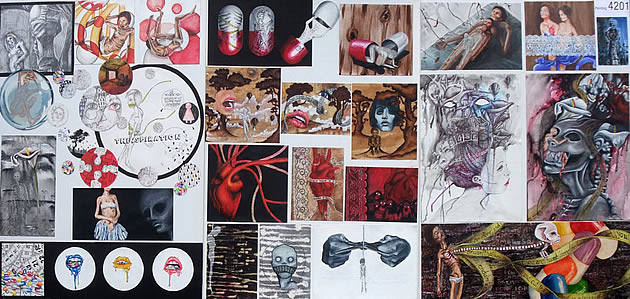 This student has used provocative imagery to explore the contentious issues surrounding human consumption of animal flesh. (Note: This is an NCEA Level 3 Painting Folio Board, awarded Excellence and Scholarship – the New Zealand equivalent of A2 Painting coursework).
This student has used provocative imagery to explore the contentious issues surrounding human consumption of animal flesh. (Note: This is an NCEA Level 3 Painting Folio Board, awarded Excellence and Scholarship – the New Zealand equivalent of A2 Painting coursework).
Painting Coursework final piece by Hera Lorandos from St. Lawrence College:
 A Level Art Ideas: This emotive final piece, exploring a topic of self-harm, is rich and raw with emotion. Based upon a student’s dream, there is a gutsy honesty to the work.
A Level Art Ideas: This emotive final piece, exploring a topic of self-harm, is rich and raw with emotion. Based upon a student’s dream, there is a gutsy honesty to the work.
Painting Coursework folio boards by Michaela Coney of Waiuku College:
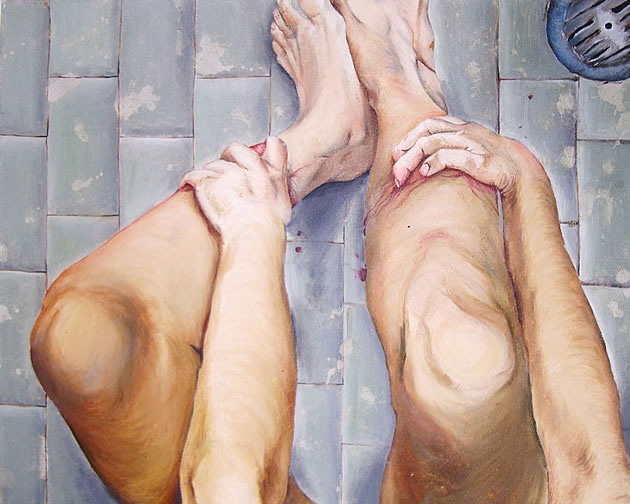 This student has used explored obsessions with beauty and our dieting / pill-popping efforts to achieve an immaculate figure. (Note: This is an NCEA Level 3 Painting Folio Board, awarded Excellence – the New Zealand equivalent of A2 Painting coursework).
This student has used explored obsessions with beauty and our dieting / pill-popping efforts to achieve an immaculate figure. (Note: This is an NCEA Level 3 Painting Folio Board, awarded Excellence – the New Zealand equivalent of A2 Painting coursework).
Note: For inspiration about how to present your brainstorming, you may like to view How to make a Mind Map: creative examples for high school Art students.
Step 2: Evaluate your ideas
Think carefully about the topics that you have written down. Use the flowchart at the end of this article to evaluate your ideas.
- Eliminate those which are ‘cheesy’ (i.e involving pink hearts and Brad Pitt), insincere (i.e. a theme of ‘World Peace’, when really this is something you couldn’t care less about) and overly “pretty” or lacking in substance (i.e. bunches of roses). This doesn’t mean that a traditionally ‘beautiful’ subject cannot be successful, (see the cupcake example below by a student from Sir William Ramsay School – image sourced from Dan China), but think carefully before proceeding with such a topic.
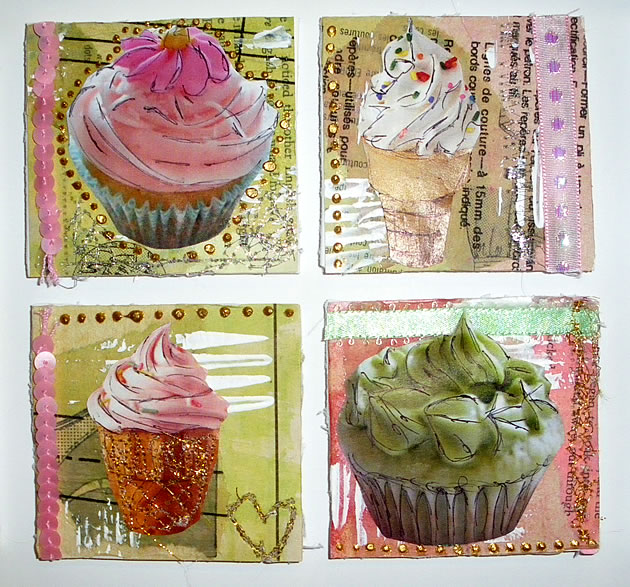 Sometimes even ‘pretty’ objects can be explored in a contemporary and innovative way, as in this mixed media cupcake work
Sometimes even ‘pretty’ objects can be explored in a contemporary and innovative way, as in this mixed media cupcake work
- Eliminate those subjects which you are unable to explore first-hand.In order to create artworks, you will need access to high quality imagery. For example, if you are exploring the way in which humans kill animals in order to consume their meat, access to the inside of a butchery or abattoir/freezing works is likely to be essential. Reliance on photographs taken by others is rarely a good idea. No matter how awesome a theme appears, if you are unable to explore any aspect of it firsthand, it is very unlikely that you will be able to do the topic justice. Remember that you will likely need to return to your source imagery several times during your high school course, so a submission based upon a particular plant that only blooms for a couple of weeks out of the year or a view of your village during a rare winter snow storm is very risky. The ideal GCSE, IGCSE or Art A-Level subject is one that you can physically return to, whenever you need – to draw, photograph or experience first-hand.
- Remove the topics for which the source material is excessively simple, i.e. containing only a few forms, textures and patterns. A small pile of cardboard boxes, for example, might inspire a great drawing, but if this is the starting point for an entire year’s AS or A2 work, the straight lines, rectangular forms and flat box surfaces are unlikely to provide enough visual variety to explore for months on end. Overly busy source material, on the other hand, is not an issue – it is much easier to simplify form and detail than it is to add back in.
- Eliminate those topics for which the source material lacks aesthetic appeal. Do not mistake ‘aesthetic appeal’ for pretty. In fact, some of the ‘ugliest’ things can be stunningly rendered in an artwork or design. Art teachers (and artists in general) often speak of finding the beauty in the ordinary or mundane: seeing the magic in that which others have discarded or forgotten (see the electrical plug painting below by Amy Thellusson from Notting Hill and Ealing High School). This does not mean, however, that anything is suitable for your A Level topic. Some scenes are genuinely unattractive and unsuitable visually. Certain object combinations (due to their particular shapes, colours or textures) are extremely difficult to compose in a pleasing way. Similarly, some items – particularly disproportionate drawings or designs by others – are very challenging for a high school student to replicate. A drawing, for example, of a doll that is proportioned unusually, may appear to be an inaccurate, badly proportioned drawing of an ordinary doll. In other words, the examiner may not realise that the doll is proportioned badly – they may think you simply cannot draw. (If you find ascertaining the aesthetic potential of your ideas difficult, discuss this further with your art teacher. Alternatively, you are welcome to join the discussion in our forum).
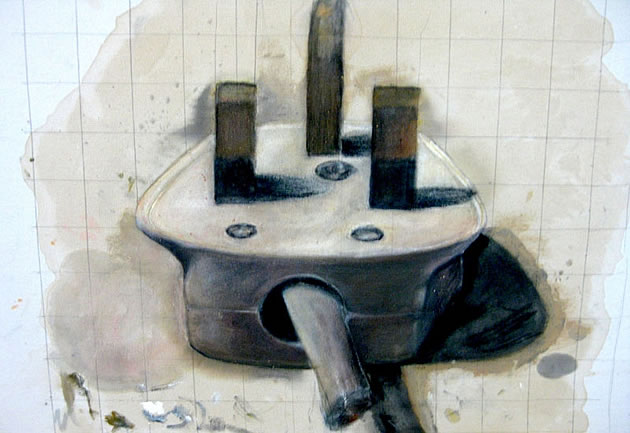 Sometimes the most mundane of objects can provide the greatest beauty
Sometimes the most mundane of objects can provide the greatest beauty
- Eliminate topics which are common or over-done (unless you have an original way of approaching this topic). It doesn’t matter if someothers have explored the same topic as you… With the millions of people in the world, it is highly unlikely that you will be the only one to explore a particular theme (in fact, this is beneficial, as you can learn from others…and no one will make art exactly like you), but, if EVERYONE is doing it – if it is a topic that the examiners have seen a hundred times before, you should think carefully about whether you have something sufficiently new and original to say about it.
- Ensure that the topic you choose is something that you really care about and which can sustain your interest for a year. If you have more than one topic left on your list, pick the thing that you care about the most.
A Level Photography piece by Kate Dunn from Cobham Hall School:
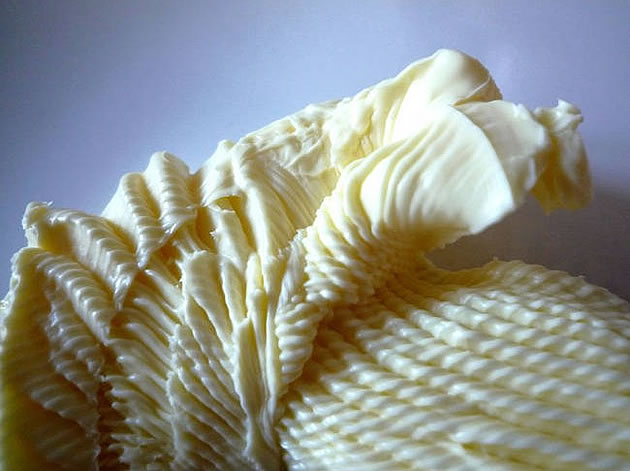 This accidental swirl of butter creates the immediate potential for aesthetic exploration: a moment found in what seems to be the ordinary and mundane.
This accidental swirl of butter creates the immediate potential for aesthetic exploration: a moment found in what seems to be the ordinary and mundane.
Painting Coursework folio boards by Melanie Nieuwoudt from Green Bay High School:
.jpg) This is an example of a tried and true portraiture theme being approached in a highly original and innovative way, exploring the interaction between artist and viewer. (Note: This is an NCEA Level 3 Painting Folio Board, awarded Excellence and Scholarship – the New Zealand equivalent of A2 Painting coursework).
This is an example of a tried and true portraiture theme being approached in a highly original and innovative way, exploring the interaction between artist and viewer. (Note: This is an NCEA Level 3 Painting Folio Board, awarded Excellence and Scholarship – the New Zealand equivalent of A2 Painting coursework).
A quick guide for evaluating ideas
The information in this article has been summarised in a flowchart, which can be used as a quick tool to evaluate GCSE, IGCSE and A Level Art ideas. The top section of the diagram contains general areas to trigger brainstorming; the bottom outlines the evaluation process.

Summary
A good GCSE, IGCSE, NCEA or A level Art coursework topic keeps you enthusiastic, creative and eager to create more. It eliminates the need for slavish self-discipline. It opens the door for you become a ‘real’ artist – making art about what matters to you.

